Progress!
Theoretically, it’s present in every industry, in every business, and in the lives of every worker-bee in their pursuit of professional glory.
But in reality, there are many times when we feel “stuck in the mud,” and real estate is no exception.
Through eighteen years and several thousand blog posts, I have lamented all that is wrong or required a little tinkering, in our industry.
Last month, we received a lengthy document from TRREB detailing some new “rules” that will come into effect on December 2nd.
Today, I would like to present the most notable of these rules, which is based on how they will affect market participants and the process of buying, selling, listing, or viewing a property, in person or online.
Let me start with perhaps the biggest change and the one that I think will be the most difficult to track and enforce, not to mention the rule that the fewest number of agents will choose to ahdere to (don’t shoot the messenger…)
Prior to reporting a transaction to the MLS System, chattles and other elements included in the sale price but not contained in the original MLS Listing Agreement shall be added to the MLS Listing in the inclusions field.
Do you see where this is going?
Do you see the implications?
And do you understand why this is important to TRREB?
Phew! Much to discuss, so let’s begin.
In a typical resale transaction for a freehold, you would expect to see the following:
INCLUSIONS: Fridge, Stove, Dishwasher, Microwave, Washer, Dryer, All Window Coverings & Hardware, All Electric Light Fixtures
Pretty standard, right?
If the seller wants to include the garden shed out back, or the sectional couch in the basement that won’t fit up the stairs, then they might do so, and this would be noted in the “INCLUSIONS” section of the MLS listing.
But what if there’s more?
What if the buyer makes an offer with the following:
INCLUSIONS: Fridge, Stove, Dishwasher, Microwave, Washer, Dryer, All Window Coverings & Hardware, All Electric Light Fixtures, EuroCave Pure Cellar Wine Fridge, David Michael Extendable Solid Wood Dining Table & Chairs, Sony Home Theatre (Including All Existing Hardware, Speakers, Wiring), Samsung Projector, Mont Alpi 6-Burner Outdoor Barbecue, Gramma’s Family Shortbread Recipe
How much is all that stuff worth?
I mean, you really can’t put a price on that shortbread receipt, since gramma’s great-gramma’s great-gramma brought that over on the Mayflower in 1620, but what about the other inclusions?
What if the buyer includes $100,000 worth of existing chattels in the APS?
According to the new TRREB rules, the listing needs to be amended to include this!
We know why, of course: accuracy.
If a property sold for $2,000,000 but there was $100,000 worth of chattels included, then we would want the historical MLS to reflect this so we can continue to accurately evaluate properties via “comparable sales.”
But where’s the proverbial “line” here?
We amend the MLS listing to include the $75,000 in imported Italian furniture, but what about the $40 HomeSense mirror?
How would this ever be enforced by TRREB?
TRREB does not have access to the completed Agreement of Purchase & Sale, and even if they did have 90,000 of these every year, is it worthwhile to comb through MLS, cross-referencing with the corresponding APS?
I agree with the spirit of the rule. But I wonder where the “line” is drawn and how to enforce this.
–
Next up is what I would call a “tie for biggest change,” since this will affect a lot of listings out there:
The following images cannot be included in an MLS Listing:
a) Digitally altered images including the use of any artificial intelligence system or technology to create, alter, or enhance images or digital staging that do not accurately depict the listing
b) Images of surrounding amenties that are not in view of the listed real estate
c) Images of advertising or marketing with messages with the exception of architectural drawings, floor plans, maps, aerial or distance photographs relating to the listed real estate which is labelled as such
d) Any persons or digital representations
Alright, the lowest-hanging fruit here is (d).
I find this very funny because I used to do a feature on TRB called “More MLS Musings” where I would consistently provide examples of awful photographs that often contain the home owner, a tenant, a child, or somebody else.
So where do we draw the line here?
Let me go to the MLS MUSINGS ARCHIVE here for a moment…
…ah, how about this:
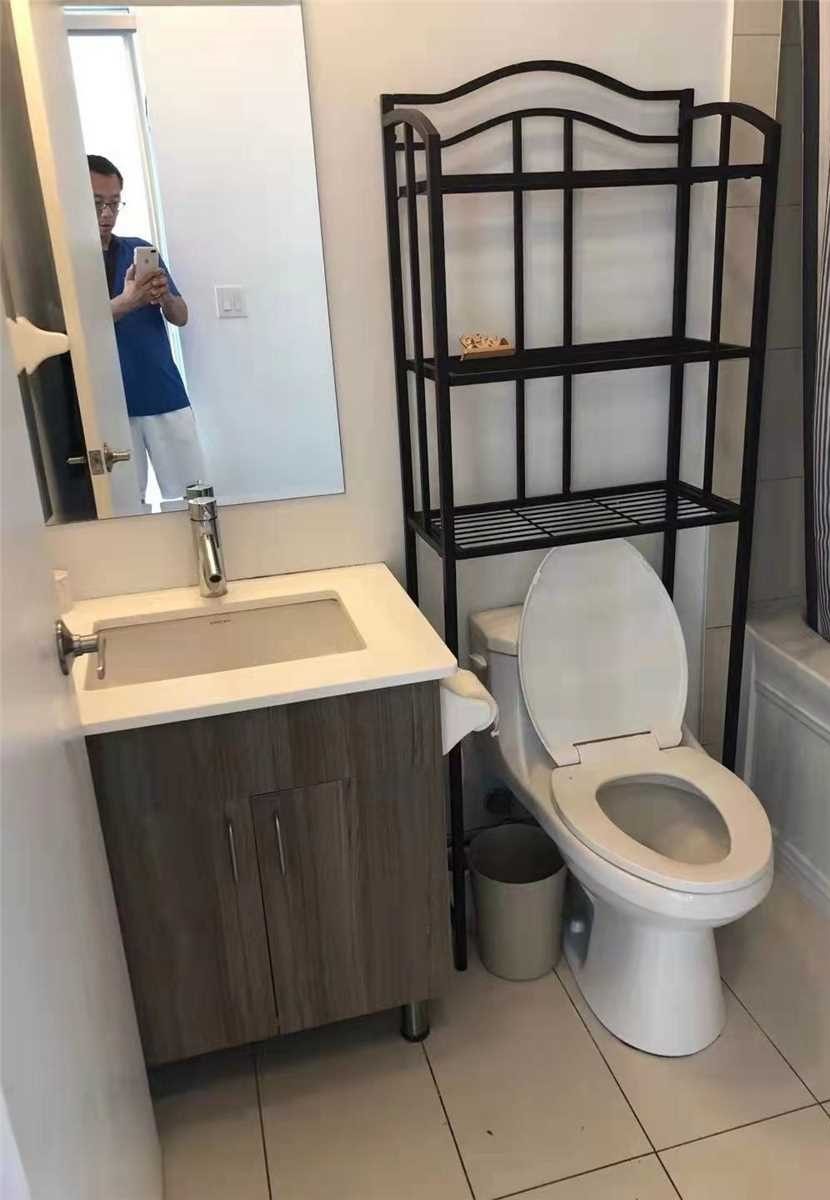
That’s clearly the listing agent attempting to save $99 on photos.
Is that allowed on MLS under the new rules?
How about this one:
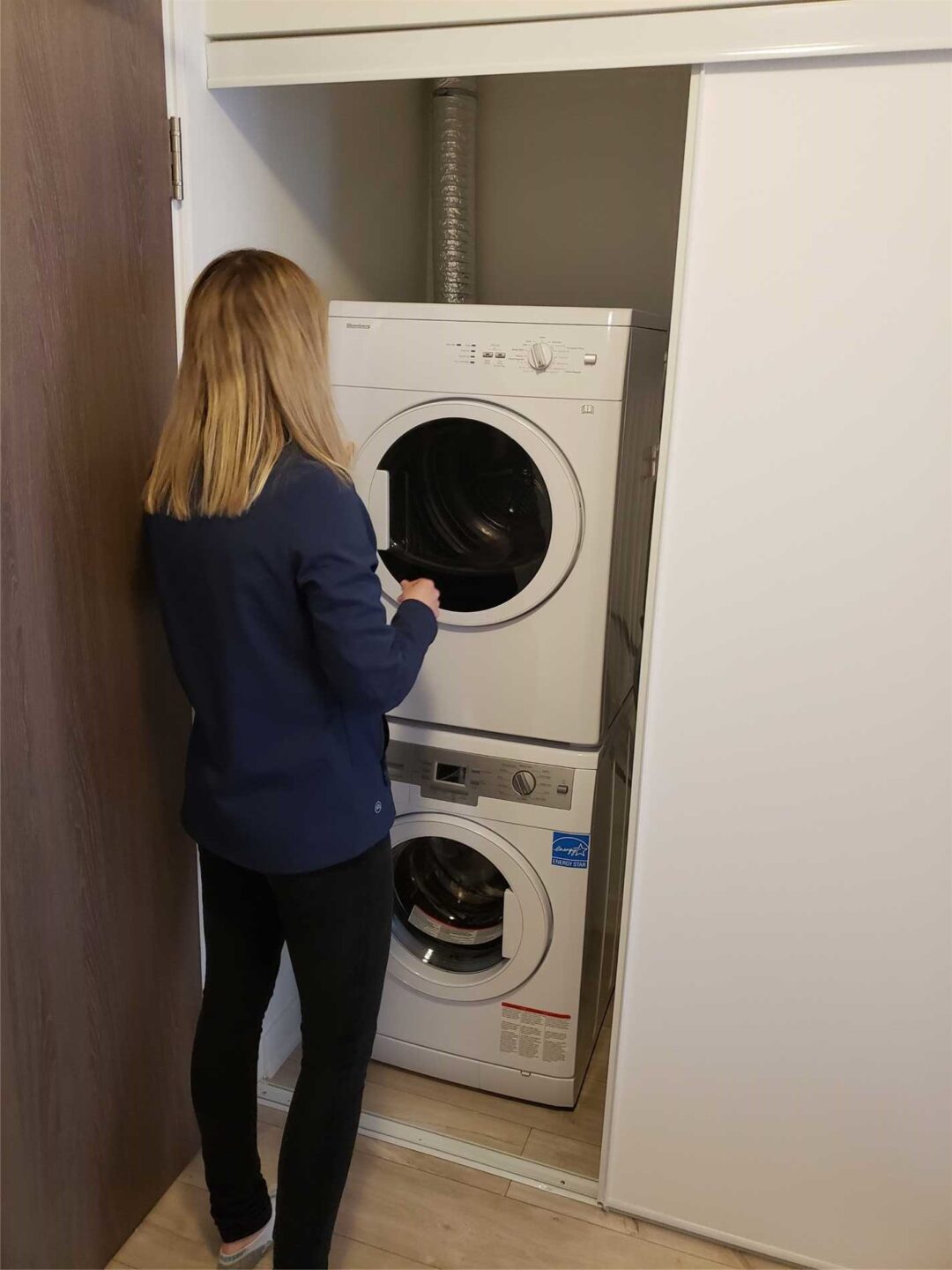
This looks like the seller inspecting a new condo during a PDI.
Could the listing agent not have waited five seconds for her to move?
How about this one:
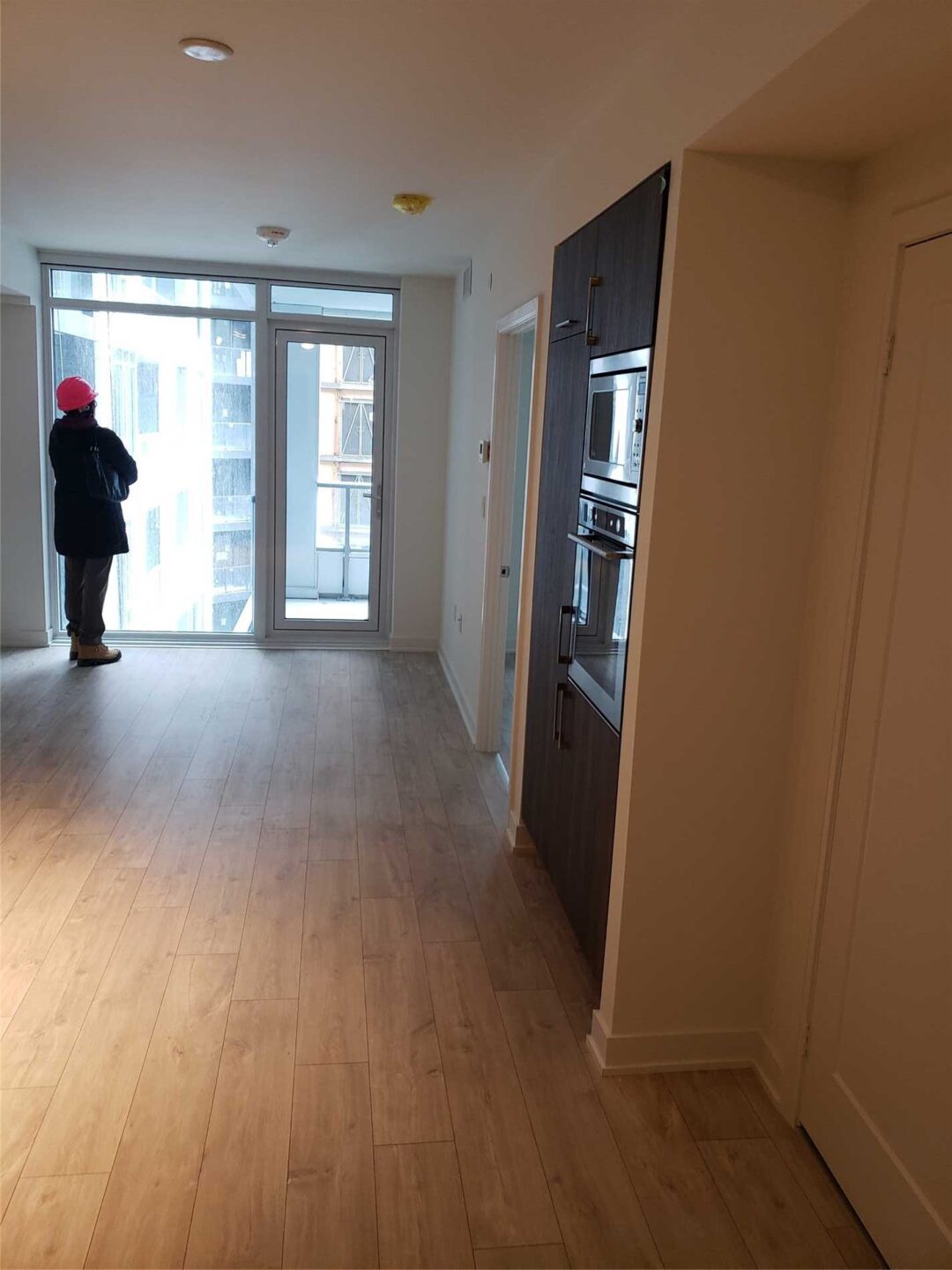
Based on the hard-hat, I would say this is definitely a representative of the developer doing a PDI with the buyer and/or buyer agent.
Are these photos allowed on MLS under the new rules?
Now, moving on to the most important part, check out section (a) again:
Digitally altered images including the use of any artificial intelligence system or technology to create, alter, or enhance images or digital staging that do not accurately depict the listing.
What about virtual staging? Is this still allowed?
Yes.
But the new rules specify the photos must “accurately depict the listing,” so agents will be required to post one unstaged photo of the property for every virtually staged photo.
The photo of the virtually staged living room must come before or after the same photo of the living room, unstaged and empty.
The photo of the virtually staged primary bedroom must come before or after the same photo of the primary bedroom, unstaged and empty.
And so on.
Virtual staging is here to stay, but TRREB is ensuring that consumers are not misled.
Now, what about “artist’s renderings” of a new development? Okay, sure, we all know what a painting is.
But then what about renovations?
Consider an “artist’s rendering” of a renovation or improvement on a property. Does that fit the definition of “virtual staging?”
Check this out:

Gorgeous!
Absolutely perfect!
Now check out what this really looks like:
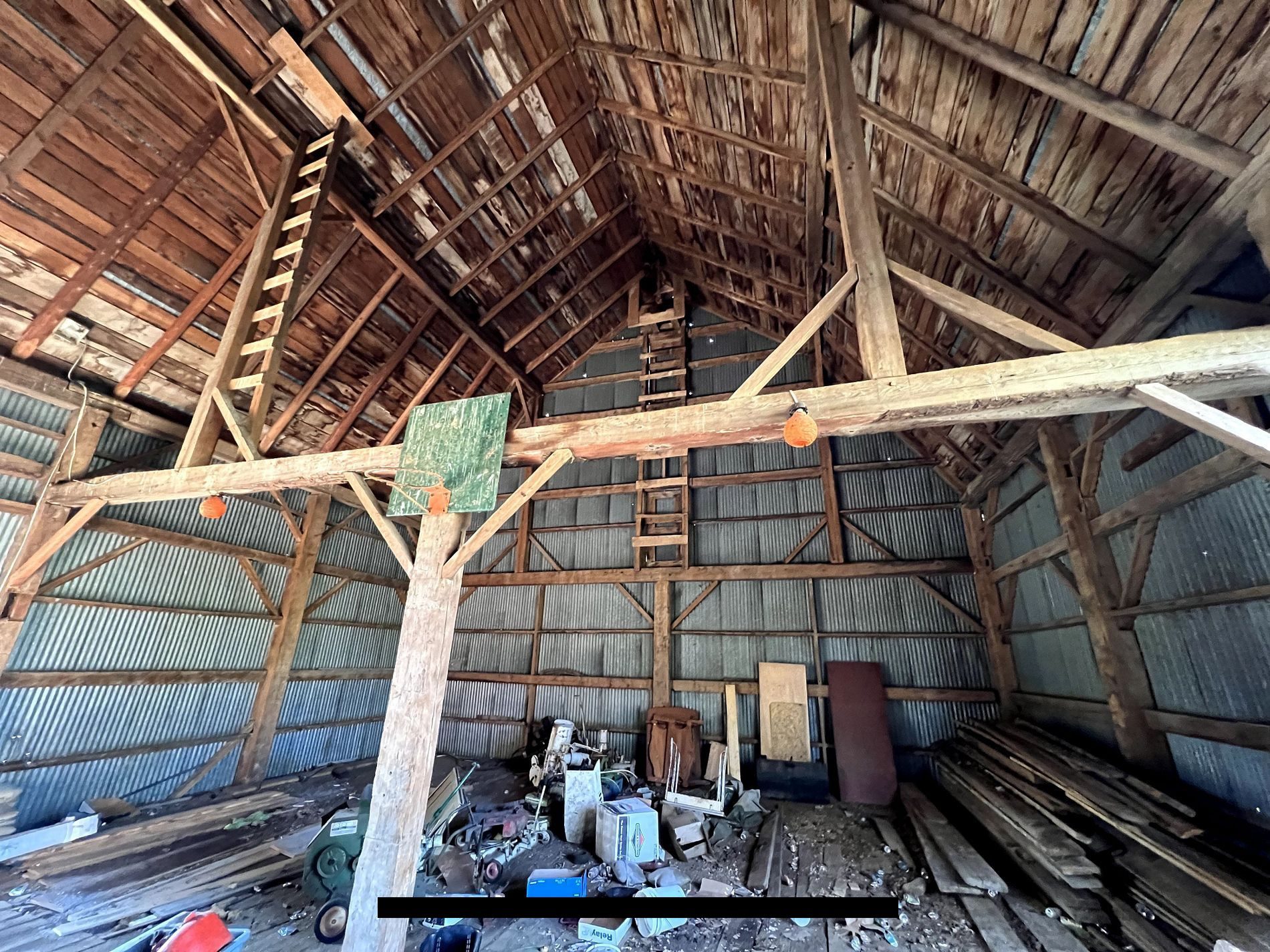
So, I ask again: what is the “spirit of the rule,” so to speak?
Now, in section (b) of the rule, we’re not including:
Images of surrounding amenities that are not in view of the listed real estate
What does this mean?
No more photos of the local bakery.
No more stock photos of the St. Lawrence Market, or the “King Street” street sign, or Harbourfront.
Exceptions are made for the gym, party room, and swimming pool within the condo building, but what TRREB is trying to do here is remove the unnecessary “fluff.”
If listing agents want to include photos of Riverdale Park in their printed feature sheets for their listing on Withrow Avenue, then have at it!
But no more photos of people doing tai-chi in the park.
–
Here’s a common sense rule:
MLS Listings appearing on the MLS System shall be immediately available (subject to applicable legislation, the rights and reasonable accommodation to occupancy) for showings, inspections, and registration of Offers.
Good. As it should be.
No more listing a property on Monday morning and noting “Showings To Start Saturday Morning Onward!”
This isn’t fair to cooperating agents and it’s not fair to buyers.
A property listed for sale on a system built on “cooperation” must be available for that same cooperation.
–
Try this one on for size:
Members are responsible for the accuracy of information submitted to the MLS System including photographs and all documentation. No language in the MLS listing shall be used to override or diminish this responsibility.
This is interesting.
But what specifically does this refer to? And how would it be enforced?
For years, I have been frustrated by listings like this:

What do you mean “Buyer to verify all details/measurements?”
Do you mean that you accept zero responsibility for the accuracy or worse, truthfulness?
Is this supposed to represent a legal claim?
“Oh, but, Your Honour, I can’t be held liable for the fraudulent misrepresentation because I wrote in the listing ‘Buyer To Verify” and they had the opportunity to do so.”
There’s nothing remotely close to “legally-binding” here and since a ridiculous one-line statement like the one above, buried in the bottom of the MLS listing, would never hold up in court.
So why do listing agents do this?
Why do we continue to see this on MLS:

Really?
The buyer has to verify the taxes?
Isn’t it the listing agent’s job to obtain a copy of the most recent municipal tax bill?
I have no idea how TRREB is going to enforce this rule, but if the idea here is – any time they see “buyer to verify,” they pull the MLS listing down, then I’m all for it.
–
This one is very interesting:
The Offer Remarks field shall display all comments related to the registration of Offers and Seller direction, including, but not limited to:
a) The date and time of the offer presentation
b) If a Seller is reserving the right to review pre-emptive Offers
c) Seller direction that the Cooperating Brokerage not be in attendance during an offer Presentation
This is new.
This is………. interesting.
I honestly can’t recall the last time that I presented an offer to a seller in person.
Pre-pandemic, that’s for sure. But even in the years leading up to the pandemic, more and more “offer nights” were being done virtually.
For those who are newer to real estate fandom, did you know that, once upon a time, we used to present paper copies of offers and do so in the seller’s dining room?
It doesn’t seem like that long ago, but based on how the industry has evolved since then, I’m sure this seems like a moment in time.
I presented my very first offer in September of 2004.
I had my buyer hand-sign six copies of the offer. Why six? Well, one “true copy” for each of:
1) Seller
2) Buyer
3) Listing Agent
4) Cooperating Agent
5) Seller’s Lawyer
6) Buyer’s Lawyer
I went directly to the condo at 86 Gerrard Street, took the elevator up to the unit, and met the sellers and their agent.
I presented our offer while we sat in the living room and the two sellers went outside to discuss. It was a divorce.
Then I was asked to step outside while the sellers and the listing agent could discuss, and eventually, I was invited back inside and told, “We have a deal.”
They didn’t even sign it back!
Good thing, however. Otherwise, I would have had to drive to my client and have her sign and initial six sets of changes on the offer!
For the better part of fifteen years, buyer agents would show up to the physical house or condo on the “offer night,” parade through the property, one-at-a-time, presenting offers, then head outside to wait in their cars.
We’d arrive at the house at 7:00pm and wait to be “called” by the listing agent. Imagine walking up the street and seeing ten other agents waiting in their cars, either for their turn to present, or for the offer procession to conclude.
It would often take four or five hours.
But those days are long, long gone.
I’m surprised to see TRREB’s new rule that requires sellers to sign a direction that the offer presentation not be in person, but it’s not a big deal. Just one more box to check…
–
You might not see the forest through the trees on this one, but don’t worry, I’ll explain:
All registered title holders must be included in the Seller field. If there is insufficient space in the Seller field to list all names, then this information may be continued in the Brokerage Remarks field.
Nobody is special.
Rules are rules.
It’s time to crack down on this:

And this:
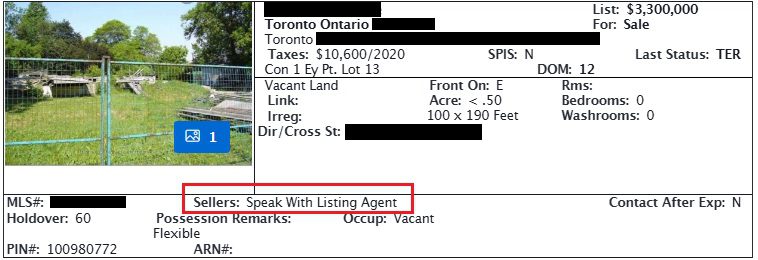
It’s funny, because many years ago when there was a battle between the Competition Bureau and TRREB, one of the figureheads at the Competition Bureau put his or her house up for sale a short time later, and under the “SELLER” field, I distinctly recall the irony when he or she instructed the listing agent to leave the field blank.
I don’t care if the Prince of Persia lists his house for sale on MLS; nobody gets to remain anonymous. That’s the rule!
–
Folks, I feel like I could do this all day!
But there’s some “nitty-gritty” that might not interest you, and I don’t want to risk boring you in advance of the next blog post.
On Monday, I want to continue this theme. I want to pretend that I was in charge for one day and had the power to enact significant changes to what we see on MLS, how we use the system, and which business practices are no longer predicted.
Have a great weekend, everybody!
































Appraiser
at 7:16 am
I have harped on this before. But why the square footage of the dwelling is not included in every listing is a mystery. MPAC has square footage data for almost every property in Ontario. This info is accessible to all members of the board for a nominal fee. It should be mandatory.
Francesca
at 8:23 am
I agree the range is too broad in the listings. Exact square footage should be mandatory. It is in most other places. I find it’s often laziness on behalf of the seller or realtor and often buyers do ask and then they have to scramble to find the answer! I would also like to see the misrepresentation of the plus one or den handled better. Often these “dens” are literally nothing but a small corner in a room where maybe you would put a Christmas tree or a plant or some shelving! It should be a separate room to be considered a den with or without windows but it should have clear separation from the adjacent rooms. I don’t even know if the old rule of a bedroom needing a window to be called a bedroom is enforced anymore with condos getting smaller and creative with their layouts.
David Fleming
at 9:01 am
@ Appraiser
You’re stealing my thunder for Monday’s post! 😂
Appraiser
at 8:50 am
Oops – sorry
Sasha R
at 10:13 am
A good start but what about listing bedrooms that aren’t bedrooms (i.e. bachelor suites, dens with no windows smaller than 7×7 or “study” cutouts – just a desk in the hallway)? What about ensuring that square footage is always listed (and not including balconies or below grade space)? I would like to see your idea about not listing significantly below expected price included without stating an offer date IN THE DETAILS….it’s so frustrating and a waste of everyone’s time to look at properties that are really not within my search parameters.
Marina
at 11:08 am
Totally a pet peeve, but I would also like the following words/phrases banned from listings:
– This is the one! (It isn’t)
– Imagine (don’t try to sell me sh*t that isn’t there)
– Unique / one of a kind (these are almost exclusively used in suburbs for the most cookie cutter crap that has a “quirky” purple kitchen or something. It’s not unique. It’s sad.)
– Luxury (again almost exclusively used on some suburban massive house with cheap finishes and awkward design)
– Special (the word you are looking for is “weird”)
– Well-maintained (expensive to fix so they didn’t bother)
– Exclamation points. Seriously. I know the house has bathrooms! And a bedrooms! The kitchen has appliances! This is the one!
Sigh. I need more coffee.
Ace Goodheart
at 12:59 pm
Interesting. We once went to view a house with a very nicely landscaped back yard, a river view, and an inground pool.
Problem was, there was no pool. The listing was digitally staged. The pool had been added to the backyard by a clever computer savvy digital stager.
The back yard was just grass. There was a large tree in the middle, roughly where the center of the pool was supposed to be (evidently the digital stager didn’t educate themselves as to the bureaucracy you have to navigate in Toronto in order to get a permit for removing a large, mature tree).
And the river?
It wasn’t in the back yard at all. The house backed onto other houses. The river was in a park down the street.
I wonder if this sort of “staging” would still be legal under the new rules?
Appraiser
at 10:58 am
Latest monthly CREA data confirms the real estate rebound is a national phenomenon. https://stats.crea.ca/en-CA/
Home sales up +30% year over year.
New listings down -3.5%.
Average price up +6%
Bryan Groulx
at 9:09 am
The new rules as outlined in PropTX (which every agent who is a member of a board affected under the system should be emailed a PDF of mandatory) is almost intentionally vague as usual.
Regarding virtual staging, to say that “a matching unstaged photo must be included” is not a dictated line in the rules. At all.
It is perfectly reasonable to do so. Just as it would be highly advisable to make sure a virtually staged photo is clearly labelled as such and a line in the MLS description “photos have been virtually staged with furniture” is just as effective as being responsible with a disclosure.
If an agent stages the house with real furniture… only for photos… and then removes the furniture because they didn’t want to pay longer term rental of staging (which has happened countless time)… and the buyer visits a vacant house on showing… is that “misleading” ? No.
The whole intention of the rule is to end gross misrepresentation of the actual listing being purchased. Not what couch exists at the time of photography.
As a responsible real estate photographer, I’m more concerned about the enforcement of clearly stated rule …
“5.05
By submitting Marketing Materials to the MLS® System the Member warrants to the Association that they have permission to use such Marketing Materials in that manner. Members shall only use Marketing Materials which they have created or purchased, including, but not limited to, all images, graphics, text, and photographs. Any permission to use such information must be provided by written consent.”
You really think agents will stop stealing my condo amenities photos from other listings even though it’s very very clearly stated not to? LOL.
Bryan Groulx
at 9:19 am
I personally feel there is a lot in your post that is your interpretation vs. actual established reality.
What is “legally binding” and won’t hold up in court in regards to measurements that “the buyer must verify” has been tested thousands of times in North American real estate court cases and local board tribunals … what is ruled is on a case-by-case basis.
Again, it all comes down to gross misrepresentation or wilful negligence. “Buyer must verify measurements” is a reasonable protective statement that HAS held up in cases where there is the most minor honest discrepancy.
When a listing is 700 square feet but the agent posts it as 1000…. obviously the misrepresentation has not held up in court. And many similar OREA hearings have resulted in penalties agent the listing agent as such, yes.
(Donald Trump called it “the worthless clause”)
Every board knows this which is why “square footage ranges” have been ALLOWED if not mandated.
And for the agents who wonder why MPAC square footage data is not mandatory on every listing eliminating the need for discrepancy statements when you bring in a a general floorplan measurer like me… some Ontario boards will not even ALLOW the MPAC data to be used.
Example…
https://s1.cdn.rahb.ca/rahbnews/wp-content/uploads/2020/09/TeranetFAQ.pdf
Why? I would interpret this as because historically many times the MPAC data could be successfully challenged as incorrect and they also don’t want to be liable.
All this does is always come down to in the end of everyone trying to shift liability off of each other.
My opinion is since all of our property values are literally dictated by MPAC square footage assessments, and they are a large entity, they should hold liability and agents should be allowed… encouraged… and mandated to city the MPAC values.
But this is not the case. It’s ridiculous in my personal opinion.
You want to try to hold a 3rd party basic measuring service of $150 accountable for exact square footage for a multi-million dollar real estate sale? But MPAC gets to wash their hands? C’mon.
The province of Alberta avoids this altogether…
https://www.reca.ca/licensees-learners/tools-resources/residential-measurement-standard/
Bryan Groulx
at 9:31 am
oh…. and one more thing since I’m on a rant. To anyone who thinks “buyers agent is responsible for verifying all measurements” is not enforceable….
I can anecdotally cite an OREA tribunal hearing from 6 years ago where the BUYERS AGENT was reprimanded for not verifying and discovering an incorrect square footage value that the LISTING agent was negligent in posting as part of the listing.
The buyer of the listing filed a complaint with OREA and the agents on BOTH ends of the sale had to pay a fine and undergo a compliance training course.
That’s how whacked out and arbitrary this system is.